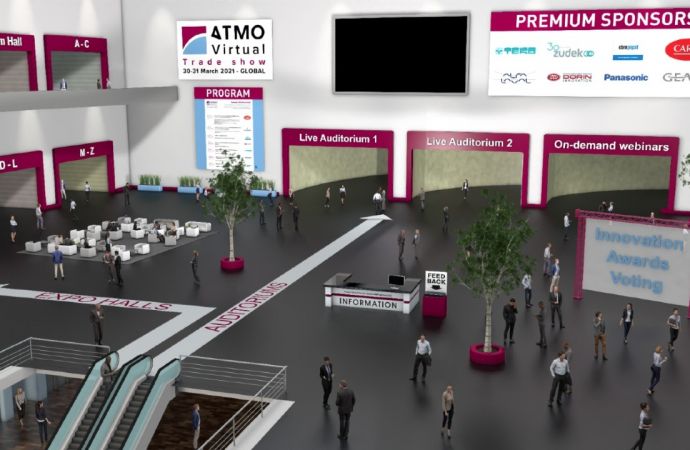The chain’s first transcritical system consumed less energy than three other store systems during an 8.5-month test.

Paul Burd, Weis Markets
“Remarkable,” said Paul Burd, manager of refrigeration engineering for Weis Markets, a Mid-Atlantic chain of 204 grocery stores.
He was referring to a chart comparing the energy usage of four refrigeration systems used by Weis stores between August 2018 and May 2019, as he stood before about 400 attendees of the ATMOsphere America conference in Atlanta, Ga., in June. All four systems are located in stores of similar size and refrigeration load.
What was remarkable to Burd was the energy savings demonstrated by Weis’s transcritical CO2 refrigeration system, installed at a 54,000 ft² (5,017 m²) store in Randolph, N.J., in July 2018, the chain’s first such system. Its energy usage during that period was 250,790 kWh, substantially below the energy consumed by the other systems, all based on HFC or HFO refrigerants: 32% less than a 1.5-year-old secondary glycol/DX system, 39% less than a seven-year-old distributed rack system, and 86% below a 23-year-old centralized DX system.
The test period included August and September 2018, when high ambient temperatures, particularly during a two-week period, challenged the efficiency of a transcritical system. Yet Weis’s unit consumed less energy during that period than the other systems.
The transcritical system, Burd said, “has really been a win for us.”
He received some pushback on the energy savings from the ATMOsphere America audience, with one attendee questioning whether the three older systems represent a fair baseline. He responded by noting that Weis commissions its stores annually to ensure they are running optimally. “We take that very seriously,” he said.
He acknowledged that the systems differ in the number of compressors used, and the older systems may have suffered an energy penalty by using hot-gas defrost rather than electric defrost, which the transcritical system employs. In the end Burd deferred to his data. “I’m just showing you the numbers,” he said.
A system evolution
Burd went into the evolution of Sunbury, Pa.-based Weis’s refrigeration technology, up to installing a transcritical CO2 system. (See also “Weis Markets’ Journey to CO2,” Accelerate America, September 2018.)
Weis began with central DX racks, then moved to distributed DX racks located near display cases. Its current design combines a low-temperature R448A central DX rack with a medium-temperature R404A chiller using a pump to circulate secondary glycol to the cases.
Its transcritical CO2 rack, an Advansor unit from Hillphoenix, employs three low-temperature and five medium-temperature compressors, with a CO2 charge of 1,100 lbs (499 kg) and an adiabatic condenser from Baltimore Aircoil. It supplies a low-temperature capacity of 343.2 kBTU/hr at -24°F (-31°C), and a medium-temperature capacity of 1,137.3 kBTU/hr at 19°F (-7°C). The system includes heat reclaim for HVAC and water.
“We looked at transcritical for two to three years,” said Burd. What held up a test was the unfamiliarity of Weis’s in- house service technicians with servicing stainless steel piping. That changed with the release of Mueller’s XHP copper-iron fittings, “which we could install ourselves,” he said.
The transcritical system has really been a win for us" - Paul Burd, Weis Markets
Still, launching its first transcritical system “was a big step for us,” noted Burd. “It was hard for me to sell the idea.”
But the company is now persuaded by the performance of the transcritical system. “It’s a learning curve that we all need to be involved in,” he said, adding, “It’s been a great experience.”
Burd had been concerned about the possibility of large CO2 losses as a result of a power failure, so he installed a back-up 2-HP condensing unit to prevent pressure build up in the surge tank. However, leakage has been minimal, limited to some access points on the rack, he said.
Weis benefited from the CO2 experience of its contractor, AAA Refrigeration, as well as from oversight and training offered by Hillphoenix and controller supplier Danfoss. “The last three weeks before the store opened, Hillphoenix and Danfoss were at the store every day,” Burd said.
Hillphoenix spent 1.5 days training six of Weis technicians on the system. “ They’re very comfortable with it now,” he said. “I can’t say enough about Hillphoenix’s training.”
Asked if Weis would now commit to using transcritical systems in future stores, Burd said the company is still monitoring the system during its first year of operation. Regarding costs, he said that while installation costs were comparable to its DX/secondary glycol system, there was still a “little upcharge” for the transcritical system, though Weis is working with Hillphoenix on design changes that could reduce the cost.
Weis has let shoppers at the Randolph, N.J., store know about the presence of a green refrigeration system. “We put signs throughout the store,” Burd said.
Related stories


